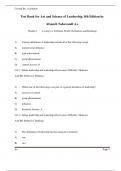Culinary arts Final exam | Questions & Answers (100 %Score) Latest Updated 2024/2025
Comprehensive Questions A+ Graded Answers | With Expert Solutions
First-degree burns - These involve only the top layer of your skin. They will look red and
feel painful, almost like a sunburn, but they turn white when pressed.
Second-degree burns - These are deeper, redder, and typically swell or form blisters
with fluid or pus.
Third-degree burns - These involve all layers of the skin, even down to the bone, and
are considered a medical emergency. Skin may not hurt due to scorched nerve endings
and will usually appear white or blackened on the surface.
Lacerations - jagged cuts in the skin. They can vary in depth and severity, but in
general, lacerations need thorough cleaning because they likely contain bacteria or
debris from the offending blade.
Punctures - happen when the skin is pierced by something sharp, like the top of a knife
or an ice pick.
abrasions - occur when skin is scraped too hard against a rough surface or with too
much force. Fondly known as "road rash," these scrapes can range from a simple graze
to a serious open wound.
Class A: - Used on regular combustibles such as wood, paper, cloth, and some plastics
Class B: - Used for flammable liquid and gas fires involving oil, gas, and other
flammables
Class C: - Used on electrical fires like toasters, blenders, or microwaves
Class D: - Used on burning metals such as sodium and titanium
chest compressions, - the process of applying repeated pressure to someone's chest in
order to get the blood flowing back to their heart.
Heimlich maneuver, - the process of dislodging an object, like some kind of food, from a
person's windpipe by applying sudden, strong pressure to their abdomen, specifically
between the belly-button and the rib cage.
HACCP - is a system that identifies where dangers exist in the production of what we
eat
, Conduct a hazard analysis - Find out where the dangers live! We must examine every
single step in the larger process of food production and identify where the major
hazards lie, as they will need to be prevented, eliminated, or controlled by a strong
HACCP plan.
Identify the critical control points (CCP) - Find the places where control will be most
effective. A CCP is just a point or step where clear control can be applied to make food
production safer.
Establish critical limits - Locate ways to measure each CCP! For professional meat
distributors, this might include refrigerator alarms put in place to sound an alert if
internal fridge temperatures drop below the recommended number.
Monitor the CCP - Find it and measure it! If you keep records of your critical limits and
how they are being met, you give yourself the necessary data to make changes or
demonstrate compliance.
Establish corrective action - If it's not working, fix it! Problems need to be identified
ahead of time, so no human beings are endangered by hazardous food.
Verification - Once you have a plan, make sure it works! This means test the product
and then test it again, and again, and again, always paying attention to ways it can be
improved.
Recordkeeping - Test it, fix it, record it! Keeping notes on these safety measures is
critical for professional food producers, as they are answerable to bigger authorities
than just grumpy family members who don't like raw chicken.
paring knife - like a lighter, more delicate version of the chef's knife.it is great for
precision jobs like peeling fruits and vegetables, slicing small items like garlic or
shallots, or cutting shapes and vents into dough. It is the perfect tool for any kitchen job
that demands more control and exactness, like coring an apple, deveining shrimp, or
removing the spines from kale.
serrated utility knife - sits somewhere between the chef and the paring knife, but its
blade is straighter and has a serrated edge, which means its bumpy ridges are perfect
for slicing through tough textures like the skin of an avocado, a firm tomato, or a French
baguette. Fondly known as a "sandwich knife,"
boning knife - is small but powerful. Because it's designed especially for separating
meat from the bone, it can be used to break down a chicken or cut steaks away from
larger pieces.
Filet knife - made for deboning more delicate meat, like fish and sea food
Cleavor - a heavy, thick knife with a sharp blade for "cleaving" meat from the bone





